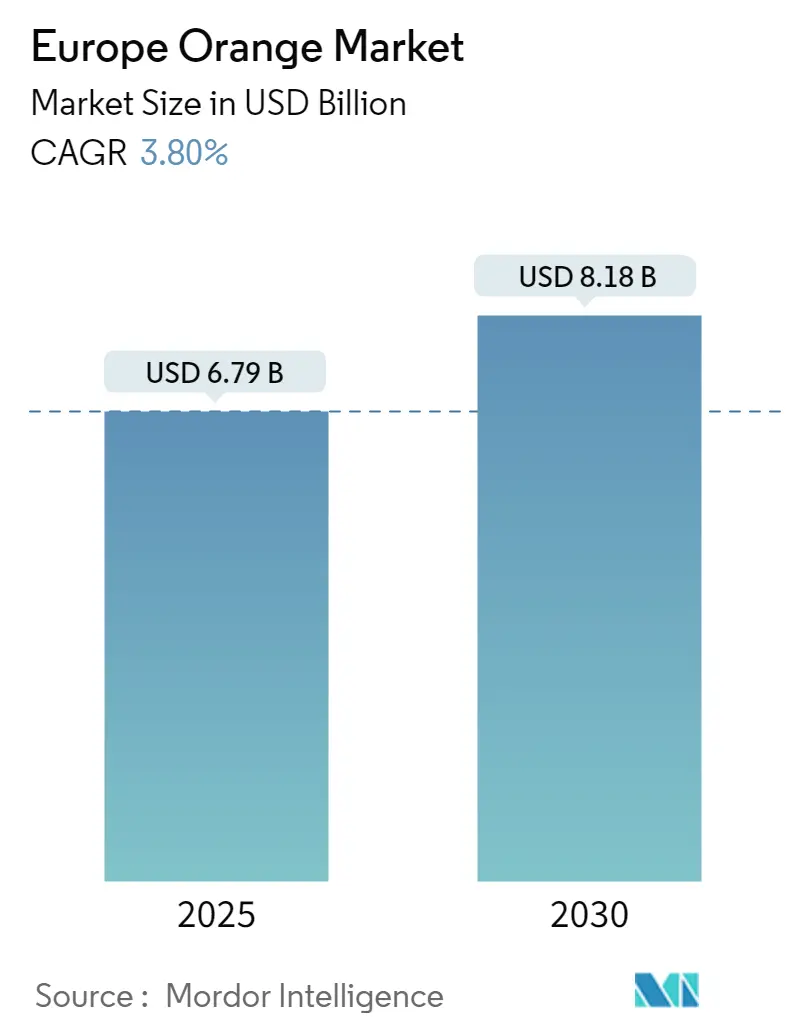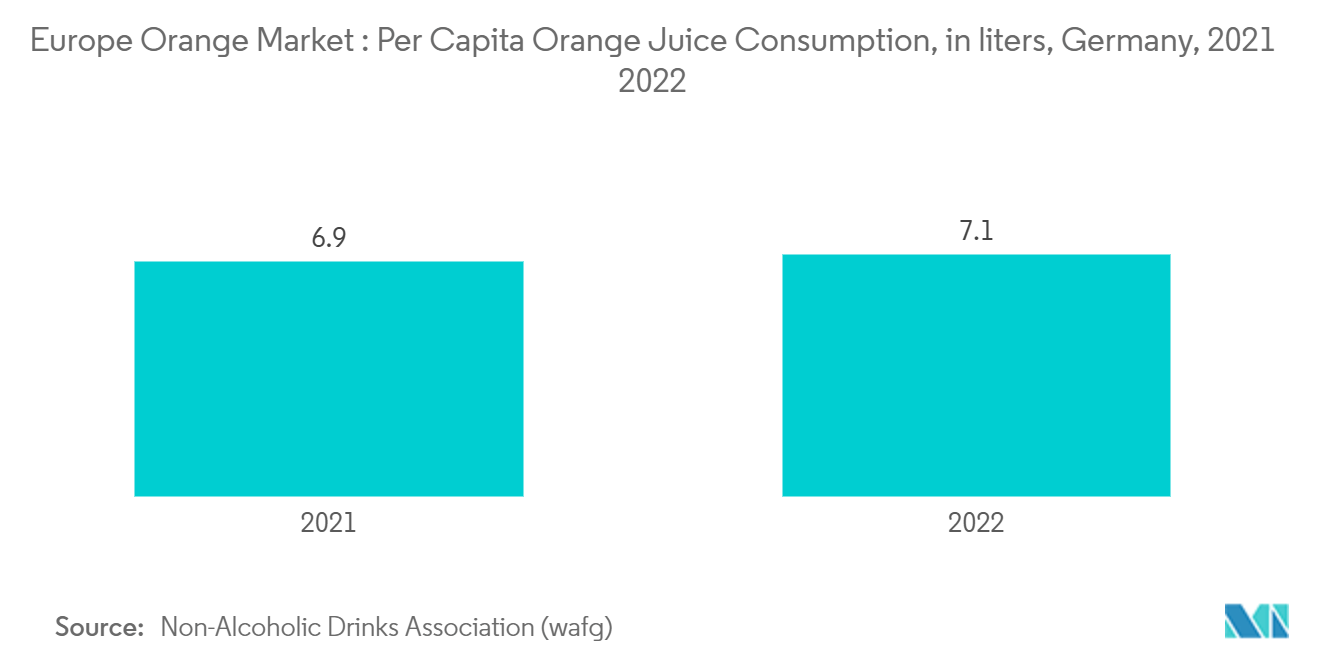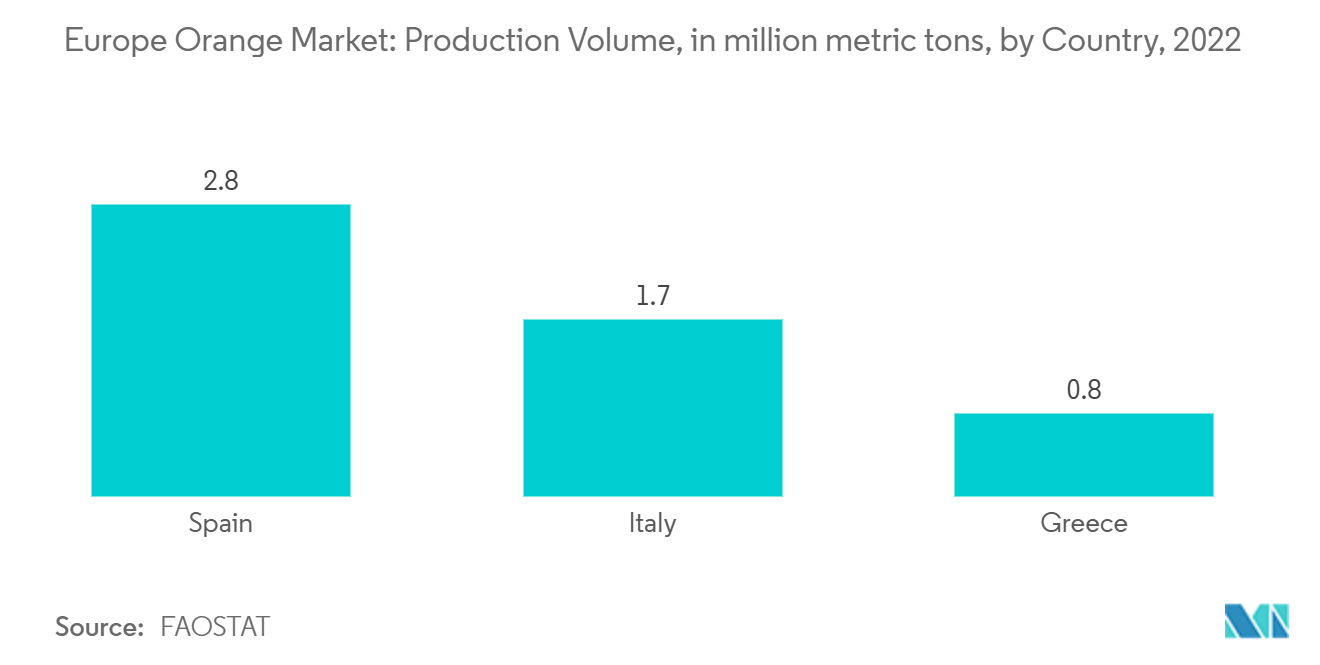
Europe Orange Market Analysis by Mordor Intelligence
The Europe Orange Market size is estimated at USD 6.79 billion in 2025, and is expected to reach USD 8.18 billion by 2030, at a CAGR of 3.8% during the forecast period (2025-2030).
- Oranges have stood out as a hallmark agricultural product of Europe, predominantly cultivated in the Mediterranean region. The most commonly grown orange varieties within the EU include Moro, Naveline, Tarocco, Valencia, Ippolito, Meli, and Sanguinello. Favorable weather conditions and robust production capabilities bolster orange cultivation in the region. The region witnesses a rising demand for orange juice. Data from the Food and Agriculture Organization (FAO) highlights Spain as the leading orange producer in the region, yielding 2.8 million metric tons in 2022, trailed by Italy at 1.7 million metric tons and Greece at 0.8 million metric tons.
- Driving the European orange market is the surging demand for orange juice and related citrus products. As consumers gravitate towards natural products, manufacturers are pivoting from artificial flavours to genuine juices, further propelling the market growth. Additionally, government-imposed tax reductions on select agricultural commodities, including oranges, incentivize producers and bolster domestic production. In light of the 2022 drought, the Spanish government introduced a Royal Decree-Law, offering a 20% reduction in the 2021 income tax base for agricultural and livestock sector individuals. This initiative, part of a comprehensive aid package, also provides benefits like increased tax advantages and subsidized interest payments, extending to orange producers. Consequently, these tax reductions play a pivotal role in bolstering market growth.
Europe Orange Market Trends and Insights
Growing demand for Oranges in Processing industry
- Consumers in the region are increasingly gravitating towards oranges, drawn by their natural sweetness, diverse varieties, and versatile applications, including juices, marmalades, face masks, and candied slices. The nutritional and functional benefits of these applications have heightened the demand for oranges in the food and beverage processing industry. As a key raw ingredient, oranges are vital in sectors such as beverage processing and cosmetics. This significance has spurred a rise in both the demand and consumption of oranges, further propelling their use in processing industries. The growing consumption of products like orange juice, orange-based cosmetics, and essences underscores the demand for oranges as a primary raw material. For instance, the Non-Alcoholic Drinks Association (WAFG) highlighted that in 2022, Germany's per capita consumption of orange juice climbed to 7.1 litres, up from 6.9 litres the year prior.
- Oranges are central to the food industry, featuring prominently in products like juices, jams, and flavouring agents. Recent advancements in processing technologies have not only improved the quality and shelf life of orange products but have also heightened their appeal to consumers, manufacturers, and retailers. This growing allure has intensified the consideration of oranges as a primary raw material across various processing industries. In September 2024, the Self Serve milkshake brand F Real unveiled its new Chocolate Orange flavour, strategically launched for the autumn season.
- Industry players are diversifying their product lines with distinctive orange-flavored offerings. This trend, spanning cosmetics, food, and both alcoholic and non-alcoholic beverages, is propelling market growth. For instance, Europe's alcoholic drinks market is on the rise, with a discernible tilt towards premium and craft products, paving the way for the emergence of orange-flavored beverages. In alignment with this trend, Jim Beam rolled out its orange-flavoured Bourbon-based liqueur in the UK in March 2023. Furthermore, Europe's stature as the world's second-largest cosmetics market, combined with its burgeoning appetite for natural ingredients, is luring companies. This scenario offers manufacturers a golden opportunity to roll out innovative orange-based products, leveraging their well-known skin and health benefits, and propelling market growth during the forecast period. Thus, the growing usage of oranges in the food processing industry aids the market growth during the forecast period.

Spain Dominates the Market in Terms of Production and Export
- Spain stands as Europe's leading orange producer and exporter, benefiting from favourable weather conditions such as a rainy spring and mild summer. The Food and Agriculture Organization (FAO) reported that Spain produced 2.8 million metric tons of oranges in 2022, making it the top producer in the region. Italy followed with 1.7 million metric tons, and Greece with 0.8 million metric tons. Valencia and Andalusia are the main orange-producing regions in Spain, where both early and late varieties are cultivated to ensure a continuous supply throughout the year.
- The Spanish fruit sector focuses on sustainable production, smart farming, digital advancements, green packaging, and high fruit quality. Enhanced harvesting and processing methods have led to increased productivity. According to the United States Department of Agriculture, 40% of Spain's orange production is consumed fresh domestically, 15% is processed (mainly into citrus juice, essential oils, and by-products), and 45% is exported.
- The International Trade Centre (ITC) identifies Spain as the world's largest orange exporter. Major importers include Germany, France, and the United Kingdom. In 2023, Germany accounted for 27.7% of Spain's orange exports, followed by France at 24.7% and the United Kingdom at 6.1%. The ITC trade map also indicates that the value of exports rose from 1.22 billion in 2022 to 1.29 billion in 2023. Consequently, Spain's high production and export potential are expected to drive market growth during the forecast period.

Recent Industry Developments
- March 2024: Louis Dreyfus Company (LDC), in partnership with Saint-Denis Dairy of the SAS Hotel (LSDH), has introduced Montebello Brasil, a new fresh fruit juice brand. Montebello Brasil offers a 100% natural orange juice product, ensuring the traceability of the oranges.
- October 2023: Mercadona, Spain's leading supermarket chain, has introduced a campaign to promote national produce. As part of this initiative, the company sold citrus fruits, including oranges, sourced from orchards in Valencia, Andalucía, Murcia, Catalonia, and the Canary Islands between 2023-2024.
Europe Orange Market Report Scope
Orange is a citrus fruit typically round and yellowish-orangish in color. It contains a significant proportion of citric acid. Europe Orange market involves a detailed production analysis (volume), consumption analysis (value and volume), import analysis (value and volume), export analysis (value and volume), and price trend analysis covering major producing and consuming European countries (the United Kingdom, France, Spain, Greece, and Italy). The report offers the market size and forecasts for volume in metric ton and value in USD thousand for all the above segments.
| Spain | ProductionAnalysis |
| Consumption Analysis | |
| Import Analysis (Volume & Value) | |
| Export Analysis (Volume & Value) | |
| Price Trend Analysis | |
| Italy | ProductionAnalysis |
| Consumption Analysis | |
| Import Analysis (Volume & Value) | |
| Export Analysis (Volume & Value) | |
| Price Trend Analysis | |
| Greece | ProductionAnalysis |
| Consumption Analysis | |
| Import Analysis (Volume & Value) | |
| Export Analysis (Volume & Value) | |
| Price Trend Analysis | |
| France | ProductionAnalysis |
| Consumption Analysis | |
| Import Analysis (Volume & Value) | |
| Export Analysis (Volume & Value) | |
| Price Trend Analysis | |
| United Kingdom | ProductionAnalysis |
| Consumption Analysis | |
| Import Analysis (Volume & Value) | |
| Export Analysis (Volume & Value) | |
| Price Trend Analysis |
| Geography | Spain | ProductionAnalysis |
| Consumption Analysis | ||
| Import Analysis (Volume & Value) | ||
| Export Analysis (Volume & Value) | ||
| Price Trend Analysis | ||
| Italy | ProductionAnalysis | |
| Consumption Analysis | ||
| Import Analysis (Volume & Value) | ||
| Export Analysis (Volume & Value) | ||
| Price Trend Analysis | ||
| Greece | ProductionAnalysis | |
| Consumption Analysis | ||
| Import Analysis (Volume & Value) | ||
| Export Analysis (Volume & Value) | ||
| Price Trend Analysis | ||
| France | ProductionAnalysis | |
| Consumption Analysis | ||
| Import Analysis (Volume & Value) | ||
| Export Analysis (Volume & Value) | ||
| Price Trend Analysis | ||
| United Kingdom | ProductionAnalysis | |
| Consumption Analysis | ||
| Import Analysis (Volume & Value) | ||
| Export Analysis (Volume & Value) | ||
| Price Trend Analysis | ||
Key Questions Answered in the Report
How big is the Europe Orange Market?
The Europe Orange Market size is expected to reach USD 6.79 billion in 2025 and grow at a CAGR of 3.80% to reach USD 8.18 billion by 2030.
What is the current Europe Orange Market size?
In 2025, the Europe Orange Market size is expected to reach USD 6.79 billion.
What years does this Europe Orange Market cover, and what was the market size in 2024?
In 2024, the Europe Orange Market size was estimated at USD 6.53 billion. The report covers the Europe Orange Market historical market size for years: 2019, 2020, 2021, 2022, 2023 and 2024. The report also forecasts the Europe Orange Market size for years: 2025, 2026, 2027, 2028, 2029 and 2030.
Page last updated on:
Europe Orange Market Report
Statistics for the 2025 Europe Orange market share, size and revenue growth rate, created by Mordor Intelligence™ Industry Reports. Europe Orange analysis includes a market forecast outlook for 2025 to 2030 and historical overview. Get a sample of this industry analysis as a free report PDF download.


